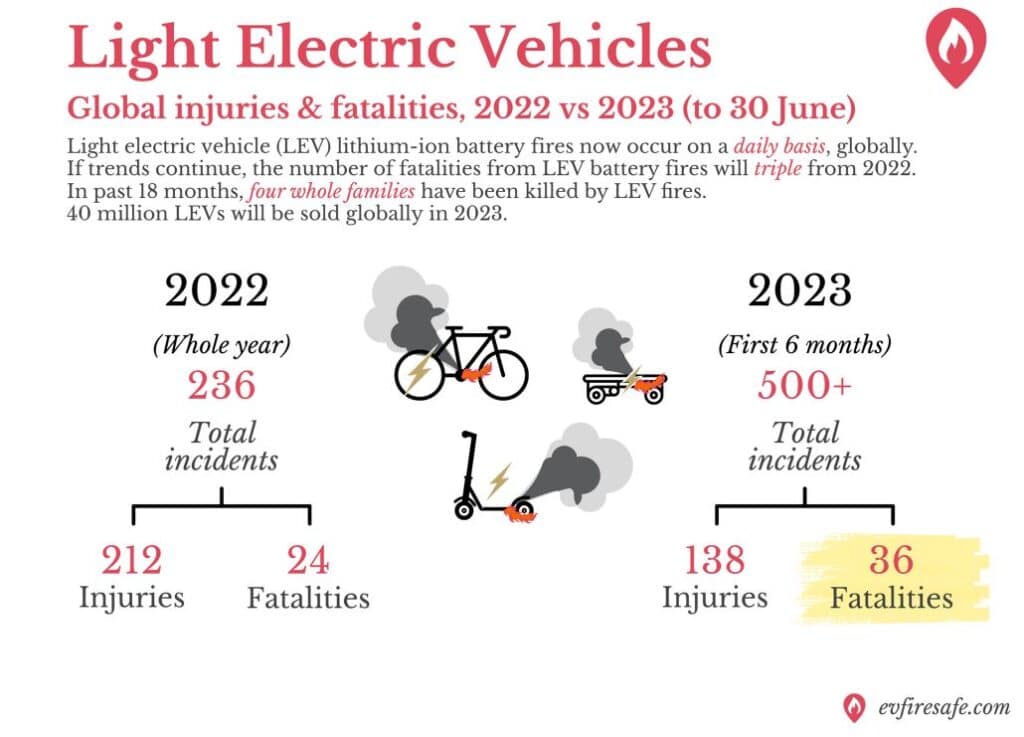Light Electrical Vehicle Fires – What to do when your e-bike or e-scooter catches fire?

Light Electrical Vehicle Fires – Small electric vehicles like e-bikes and e-scooters are becoming more and more common. While these eco-friendly modes of transportation offer convenience and reduce emissions, they also come with a growing concern: lithium-ion batteries. As the popularity of these lightweight electric vehicles increases, incidents involving lithium batteries have also been on the rise.
According to EV Fire Safe, ‘The world is experiencing an LEV-olution’, with around 40 million electric bikes, scooters, skateboards, unicycles & hoverboards expected to be sold in 2023. But lithium-ion battery fires in these Light Electric Vehicles (LEVs) are causing multiple fatalities, injuries & property losses globally. Their data even shows that, with regard to lithium-ion battery fires, the primary risk to life & property safety is from LEVs (light electric vehicles).
‘The world is experiencing an LEV-olution’ – EV Fire Safe.
What is a LEV?
Where EV stands for ‘Electric Vehicle, LEV stands for Light Electric Vehicle, also referred to as Personal Mobility Device (PMD). Light Electric Vehicles (LEVs) encompass electric bikes, scooters, skateboards, unicycles & hoverboards, with 40 million being sold globally in 2023.
Why are LEVs a risk to safety?
LEVs are powered by a lithium-ion battery (LiB) pack, consisting of multiple cells that contain an enormous amount of power in a small space. When these batteries are used and maintained properly, incidents with lithium-ion batteries are relatively rare. However, with the rise of LEVs, lithium-ion battery fires now occur on a daily basis according to EV Fire Safe.
Data shows that the number of fatalities from LEV battery fires will triple by 2023. In the whole year 2022, there were 212 injuries due to LEV battery fires, of which 24 were fatal. But when we look at the first 6 months of 2023, there were already 138 and even 36 fatalities. An alarming trend.

How many LEV Battery fires are fire agencies attending?
Lithium-ion battery fire incidents have surged on a global scale over the last half-year, with prominent organizations like the London Fire Brigade and the New York Fire Department responding to electric vehicle battery fires regularly.
Nonetheless, you don’t need to be a metropolitan firefighter to experience the hazards associated with electric vehicle battery fires. Firefighting peers located in the tranquil rural community of Bacchus Marsh in Australia faced an electric scooter fire in late 2022, followed by an electric skateboard fire merely two weeks later. Both incidents occurred in privately owned residential properties.
‘Make no mistake, LEV’s are catching fire, killing people and burning down properties on a daily basis, globally’ – EV FIRE SAFE
Why are LEV fires so hard to put out?
Thermal runaway in lithium-ion battery (LiB) cells occurs when they are ‘abused’, leading to uncontrollable self-heating. The heat from one abused cell can trigger a chain reaction in nearby cells. Unlike conventional fires, LiB cells generate their own oxygen and hydrogen during thermal runaway, making them self-sustaining fires.
Firefighters combat these fires with lots of water, but there’s a risk of secondary ignition if cells aren’t cooled sufficiently. This is why just water is simply not enough to control an LEV or any other EV fire. A test involving a partially burnt e-scooter battery pack submerged in water for three months even showed that one cell retained a voltage of 3.69 V, highlighting the potential danger of stranded energy.
How to deal with Light Electrical Vehicle fires?
In our research to find a fire agency that had a published standard operating procedure for LEV battery fires, we were unable to find any. It seems like Fire Departments haven’t figured out yet how to best fight these fires or even Electric car fires.
While submerging the LEV in water seems like the best option at first, it is nearly impossible to pick up a burning LEV. A safer choice would be to use a (small) Fire Blanket, isolating the fire and making sure collateral damage is kept to a minimum.
Our Fire Blanket, which is already being used worldwide for Electric car fires, is also available in smaller sizes. These smaller Fire Blankets are lighter, making it easier to isolate fires on Light Electrical Vehicles.
After the fire is contained by the Fire Blanket, trained firefighters can submerge the LEV in water. This is important to make sure the battery fire doesn’t re-ignite itself.

Light Electrical Vehicle Fires – What we can offer you at Fire Isolator
The Fire Isolator concept offers an innovative approach in controlling Electric Vehicle Fires. Our concept has been developed through testing and best practices in the field, by ourselves and by our dealers.
We know that fighting EV fires can be challenging, and we are honest with our customers and dealers: there is no one-size-fits-all solution. This is why the Fire Isolator Concept focuses on proactive measures to minimize damage beforehand.
Our Fire blanket, which has a temperature resistance of up to 1600 degrees (or 2900 Fahrenheit), is the best way to control and isolate electric vehicle fires. The Ultimate Fire Blanket contains flames, smoke, and toxic fumes when placed over the burning vehicle, whether it is a car or an e-scooter.
Based on live lithium-ion battery fire tests that were performed by our dealer in Switzerland, two layers of our blanket can even hold any flying debris from an exploding battery under the blanket.
The blanket is available in multiple sizes upon request.
We also offer training in using the Ultimate Fire Blanket for Light Electrical Vehicle Fires.

